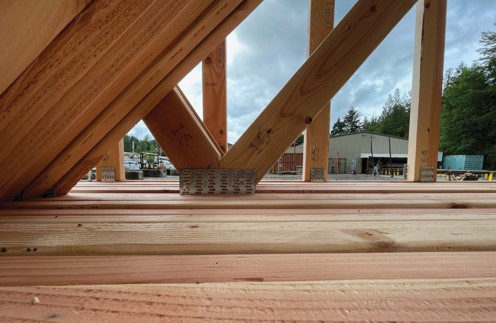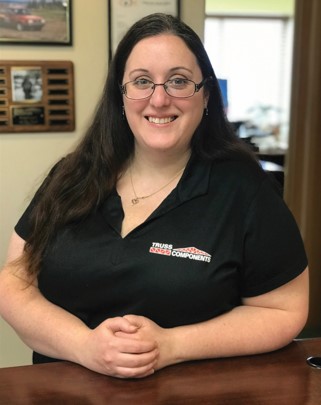Question Your Culture
Truss Components of Washington’s journey to creating a more diverse workforce
Sometimes the simplest questions can spark the greatest transformations. When Chad Johnson, president of Truss Components of Washington, asked his production manager why they don’t get any female applicants, his reply was that given the company’s current workforce, women applicants might not feel safe. Johnson responded, “I saw two problems with his answer. One was that we had a workforce that wasn’t representative of local demographics, and the other was that anyone, not just women, might consider our workplace unsafe. It also bothered me that it wasn’t necessarily unsafe from the standpoint of safety practices and machinery. It was the attitude and background of some of our employees that made it feel unsafe.”

Change the Culture
Women in truss manufacturing have historically been underrepresented, and the inability to hire great talent is a consistent issue plaguing the industry. The conversation between Chad and his production manager launched an effort within Truss Components of Washington to change its company culture to one that was welcoming to all, and to remove barriers to hiring a diverse workforce that was reflective of the broader demographics of the region.
“I had a gut feeling that diversity would be beneficial and I just always considered it odd that the company is so polarized to men only,” said Johnson. “Being raised by a single mom and surrounded by strong women most of my life, I recognized that women are capable of doing most any job that a man can do.”
The focus on encouraging more women to apply made sense to William Blankenship, the company’s operations manager, who had previously worked in other manufacturing industries that were dominated by women, such as millwork operations. He believed that some of the issues stemmed from an outdated idea of how the work had to be accomplished.
“When I first got into the truss industry, the attitude was, ‘That guy was a framer. He’ll make a great truss manufacturer,’” said Blankenship. “But we’re not construction workers. We’re manufacturers. It’s represents the current mindset of the industry. That change has occurred more rapidly through automation and what we’re doing.”
Change the Work Experience
The addition of automation has made aspects of production less physically demanding regardless of an employee’s gender. “When I first got here, you had to lift 100 pounds on a daily basis. Not anymore; now it’s 50 pounds, many times with help,” says Nancy Thompson, human resources administrator for Truss Components of Washington. “I don’t want to jinx us, but our moves to increase our workforce diversity have cut our injury rate in half. When we see injuries, they are predominantly minor injuries now. They’re not shoulder, knee, or back injuries [as in the past].”
 Nancy Thompson
Nancy Thompson
Of course, changing company culture doesn’t happen overnight - it takes time and effort. A true shift in culture is more than just words on a poster or sending out an email. Culture must be embraced by everyone in the organization, and that takes an investment by the entire workforce.
“Once that culture change had been made, then we were able to advertise our positions in good conscience for women and men alike,” Johnson continued. “We work closely with several staffing agencies and we asked them to not filter candidates based on gender.”
Change the Priorities
Johnson explains the culture they established is based on personal growth first, with company growth as a product of that individual contributor’s growth.
“We have our core purpose, values, mission, and if people aren’t intentional with those, even if they’re a high performer, they don’t last as part of the team,” says Johnson. “And if you have someone that checks the culture box, but is not able to do the work, they can’t stay on either.”

As a result of focusing on the culture, Johnson says they have a group of people that care about each other and look out for each other and enjoy working together. “They value the company way more than some of the employees that we had under that previous culture,” he said. “They recognize the company is looking out for their best interest as employees.”
Changing culture is not easy. It's possible, but it takes effort and buy-in from all parties from the leadership to the frontline workers.
“Honestly, I did everything I could to get everyone on board,” said Blankenship. “We explained to them that everyone has to be team players. We won’t tolerate certain behavior here. If you don’t meet the culture, you’re not a good fit because we put an emphasis on culture.”
Change the Hiring Process
During the interview process, the company focuses not only on culture, but also on skills and interest. It requires that each interviewee take a behavioral assessment, which provides data to help management understand how each person is motivated.
For instance, the company seeks task-oriented team players for its production line workers, individuals who are patient and able to provide consistent, high-quality work. One of their newer employees, Grace Hoepfner, has proven to be an ideal fit for the company on all counts.

Hoepfner’s behavioral data is a great fit for the ideal production worker job model, which are the ranges highlighted by the brown rectangles.
“I really enjoy the work,” said Hoepfner. “I personally couldn’t sit at a desk all day. That's not how I grew up. I worked for my dad, who was a mason.”
 Grace Hoepfner
Grace Hoepfner
Truss Components of Washington now has two women on its staff of 13 production workers. In addition, three of their six salespeople are women. “I would tell anyone interested in the work that it’s really good work,” said Hoepfner. “You definitely keep busy and it’s fulfilling. It's good pay. Good benefits. Good atmosphere. Good people. Everyone is super supportive and they really help each other.”
The Bottom Line
A casual conversation between Truss Components’ president and his production manager about the company’s workforce led to some serious corporate soul-searching. It was obvious that a major change was needed. The company was quick to respond to the challenge of altering the composition of its workforce, resulting in a more diverse workplace that is more efficient and safer than it had been in the past.
About the Author: Dolly Penland, President & CEO of Business Results, a PI® and CATIL Certified Partner and Talent Optimization consultancy, works with organizations to help them hire and manage their talent to their highest potential. She specializes in multiple areas including business sales growth, turnover reduction, and leadership development.
